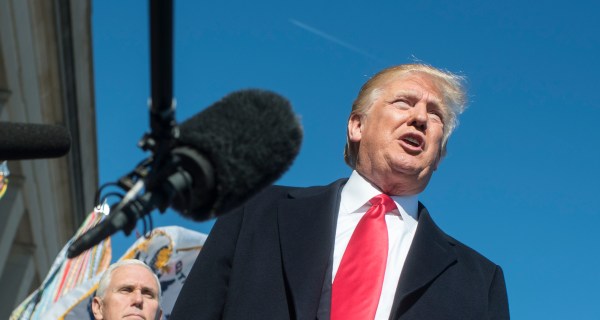Trump wants a DOGE. An Obama-era tech official has some tips.

Jennifer Pahlka, a former top tech official in the Obama White House, understands the idea behind the coming Trump administration’s Department of Government Efficiency — or DOGE. But in her opinion, co-leads Elon Musk and Vivek Ramaswamy are going about it wrong.
“I wish that they would actually do it the right way, which is working with Congress to make the real reforms,” Pahlka, former deputy chief technology officer for the Obama administration, told FedScoop in a recent interview. That includes civil service reform, she said.
Currently a senior fellow at both the Niskanen Center and the Federation for American Scientists, Pahlka also suggested the group should be working directly with people already dedicated to bringing about a more effective federal government such as public servants and outside organizations, including her own. Not doing so, she said, is a missed opportunity.
Pahlka is a notable voice when it comes to discussing the need for a more effective federal government. Her 2023 book “Recoding America” explores why government is failing to meet the moment of the digital age and what can be done to fix it. She also founded Code for America, a nonprofit dedicated to improving government services.
Although “department” is in its name, the DOGE is no government agency. Trump announced the creation of the DOGE earlier this month as an organization outside of government that will be led by Musk and Ramaswamy. The objective of that group will be to work with the White House Office of Management and Budget to “drive large scale structural reform” and take an “entrepreneurial approach to Government.”
So far, to make those changes, Musk and Ramaswamy have talked about reducing the federal workforce, cutting regulations, and eliminating wasteful spending, which they’ve called attention to in posts on Musk’s X platform. But the effort has also attracted criticism for, among other things, focusing on mass cuts to the workforce and conflict of interest concerns with Musk, whose companies contract with the federal government, at the helm.
Pahlka’s comments to FedScoop on the DOGE came after remarks she delivered at a leaders conference in Washington, D.C., on Nov. 21 hosted by The NewDEAL, a network of progressive Democratic state and local elected officials. In that speech, Pahlka discussed the barriers of government bureaucracy that prevent the implementation of policy and used the concept of “controlled burns” in fire management as a metaphor for how leaders should approach government work.
Those comments echoed a recent installment of her newsletter in which she addressed the Musk-Ramaswamy endeavor. There, she acknowledged where the instinct for the DOGE was coming from, but criticized the bluntness of the tools the duo appears to be selecting to achieve their mission.
When asked for a response to Pahlka’s remarks about the DOGE working with Congress and others who have been working toward efficiency, Trump-Vance transition team spokesman Brian Hughes provided a statement about the aim of the group.
“Under President Trump’s leadership, the Government Efficiency effort led by Vivek and Elon will target waste and fraud throughout our massive federal bureaucracy. They will work together slashing excess regulations, cutting wasteful expenditures, and restructuring Federal Agencies,” Hughes said.
The following excerpts from FedScoop’s interview with Pahlka have been edited for length and clarity.
FedScoop: We’ve seen the upcoming administration talk about the DOGE and talk about efficiency. What do you think is viable in terms of that project and what they could potentially achieve?
Pahlka: I mean, I’ll start by saying that I understand and validate the problem that they’re trying to solve, right? They’re going to have some limitations. They’re set up outside of government. What I think people are assuming is that they’ll sort of whisper in the ear of Trump and his OMB director, and so we’re talking particularly about executive action, which is limited, right? It’s limited what you can do if you’re relying largely on executive action.
I think initially, the way they were communicating, there was a sense that they didn’t really understand that Congress would need to be involved. But there was that op-ed today that I think started to acknowledge that, so that was good. But, you know, I wish that they would actually do it the right way, which is working with Congress to make the real reforms.
At first, Vivek Ramaswamy talked about what I call the Thanos strategy — just half of people, right? Well, they then looked at the law and saw that the law governs how you can do reductions in force in government, and you’re not allowed to use performance as a basis for it. And that’s often true in the private sector too. But to say we’re just going to do reductions in force, and it’s going to be kind of arbitrary, and honestly, because it will target the newest people and the lowest levels, right? Some of the innovators, people who’ve come in more recently, they’ll be gone, and they’ll be left with folks who — there will be some wonderful innovators there too — but you’re mostly gonna be left with people who’ve been in the agency for a really long time.
What they could do is work with Congress on actual civil service reform so that we can hire properly with the use of assessments and get rid of under-performers reasonably, right? And actually, if you do that, then you could do a reduction in force based on performance, and [Musk] is from Silicon Valley, where merit rules, why wouldn’t you do the little bit of extra work? The extra work that’s required to get the civil service rules and operationalized rules that we need so that we can just have a much healthier civil service.
FS: Are there any opportunities here to start a conversation throughout government when it comes to efficiency? Even outside of the DOGE, if this is something the administration is interested in, where do these opportunities lie in agencies maybe to lean more into the efficiency conversation?
JP: I think that lots of people in agencies who care about outcomes, who care about serving the public, have been wanting an efficiency conversation for a long time. They might not use that word. I think the proper word more is “effectiveness” or to be able to deliver for the American public. Efficiency just speaks to cuts. You know, people don’t care — I don’t think — that much about the cuts. They want their services to be better and easier to use. They want disaster relief to get to them quicker. They want the IRS to be able to pick up the phone when they call. Just cutting is actually going to get you longer wait times to pick up the phone, which I don’t think is what the American public wants. But to the degree that they are using this word efficiency as a way to talk about reducing the accretion of policy and procedure that makes it hard to get stuff in government, I think that conversation has been welcome.
FS: What would they actually need to do to be successful? What are the steps they would need to follow to have a successful conversation about efficiency and government?
JP: The number one thing they should do is go talk to the public servants who’ve been trying to do this before they got here — who know what regulations could be rolled back in a way that would make delivery easier without actually hurting people and hurting processes. You know, I used the metaphor of controlled burn. Those people would know how to set a controlled burn so that we can clear out some of the cruft without creating a mega-fire that destroys every family and building in its path.
I completely understand that their mindset is: ‘I’m coming in from the outside, and I want to not be captured by the thinking in D.C.’ But they’re missing the greatest leverage they could have by not tapping people who’ve been working on this, and that is a bipartisan coalition inside and outside government. We’ve got Niskanen Center, Federation of American Scientists, Foundation for American Innovation, PopVox Foundation. All of us have been working on these things for years, and we’re all tapped into people in agencies who would be fantastic partners at making government more effective, and I think in that work might also make it more efficient. They would do very well to reach out and hear from those people.
FS: When it comes to technology and the transition, what are you watching in terms of the Trump administration and what they might do with technology and IT policy?
JP: I have only heard one specific thing, which is rescinding the AI order. Have you heard others?
FS: No, that was the one that I heard of as well.
JP: Coincidentally, I have been somewhat critical of the AI executive order. Not that it is a bad document, but that when guardrails like equity studies, which in theory I completely agree with, are operationalized they take right now an average of four years, and that’s just one of the requirements in the AI EO.
So I think it’s a good thing to go back and look at that and say how much of this is meaningful guardrails, and how much of this is actually just going to turn into total barriers to adoption of AI? I think a smart reform would be to look at that and figure out how to make those studies quicker and easier to do — how to reduce the burden on public servants so that they can actually evaluate AI well rather than just rescind the whole thing. So, you know, I think we’re stuck between two poles where what we really want is something in the middle.
But I also think that what people miss about AI is that we were bad at technology before AI, and now we’re going to be bad at it with AI for all the same reasons, like this is work we should have done. We’re set up to contract with vendors to deliver on a preset list of requirements that don’t actually add up to whether the software works. We haven’t fixed that, so now we’re going to do that with AI vendors, and it’s not that different, and the reforms that are needed to get AI working in government in a way that’s safe and responsible and effective, are the same reforms that we needed for regular internet era software before the AI revolution.





